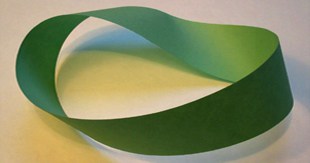A cube has six sides. A sheet of paper has two sides. Is it possible for an object to have just one side? Surprisingly, the answer is yes! You need just three things to make your very own one-sided object: a pair of scissors, some sticky tape, and a sheet of A4 paper. Now, follow these simple steps.
- Cut a 5 cm wide strip from the long side of the A4 sheet.
- Take your strip and twist one end, so the other side of the paper faces upwards.
- Still keeping it twisted, tape one end of the strip to another.
Congratulations, you are now the proud owner of what mathematicians call a Möbius strip (pronounced moe-be-us) – first discovered by the German mathematician August Ferdinand Möbius in 1858. It might just look like a twisted loop, but this strange shape really does have only one side. If you don’t believe it, get a pen and start drawing a line down the middle of your Möbius strip. Keep going round without lifting off the paper, and eventually you’ll end up at the point where you started.
How is that possible? It turns out, it’s all in the twist. By taking your two-sided strip of paper and giving it a half-twist before sticking the ends together, you make one side blend into the other.
The magic of Möbius
The Möbius strip has some other strange properties besides its one-sidedness. Try cutting your Möbius strip along the line you’ve drawn. You might expect to end up with a pair of Möbius strips, but that doesn’t happen. The result is actually a strip that is twice as long as the original, and with four half-twists instead of one. This shape has two sides – remember, you can test this by drawing a line all the way around.
The magic of the Möbius doesn’t end there! Cut the strip a second time along the line you’ve drawn, and see what happens. The strip splits in two, but the new strips are joined together. Look closely and you’ll notice that each strip has four half-twists, like the strip before. Is it possible to explain the odd behaviour of the Möbius strip? Why does one cut make a larger strip, but two cuts make a pair of strips? Is the number of twists important? Experiment by making strips with one, two or three half-twists, and see what happens when you cut them. Is there a pattern?
Despite their weird behaviour, Möbius strips actually have practical uses. A conveyer belt made from a Möbius strip lasts twice as long because it uses both sides of a normal strip, and some polymers are shaped like a Möbius strip. Mathematicians have a special name for the study of shapes like the Möbius strip – topology. Scientists use this type of maths to research everything from robots to the shape of the universe. You may not realise it, but maths lessons are preparing you for a world of possibilities!







